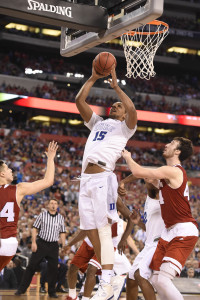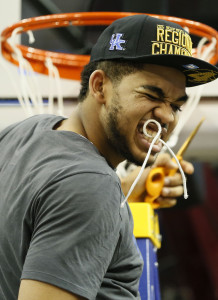Jahlil Okafor arrived in Durham with a huge set of expectations placed on his broad, young shoulders. He was the projected 2015 No. 1 overall pick by many experts prior to his first jump ball at Duke, and the 19-year-old certainly didn’t disappoint in his lone collegiate season. Okafor departs campus as a national champion, but not necessarily the top ranked player in this year’s crop of draftees.

Courtesy of USA Today Sports Images
Okafor averaged 17.3 points, 8.5 rebounds, 1.3 assists, and 1.4 blocks in 30.1 minutes per contest across 38 games. His shooting numbers were .664/.000/.510. He earned Freshman of the Year honors from the U.S. Basketball Writers Association and was a consensus first team All-American. Okafor led the ACC in PER (30.7), field goal percentage (.664), offensive rebounds (134), field goals made (279), and total points (657).
Despite all of his collegiate success, Okafor lost his grip on being the consensus top rated prospect as the season wore on. This wasn’t because Okafor failed to deliver on his promise or was viewed as any less of a franchise-type player at the next level. It was simply a result of Kentucky’s Karl-Anthony Towns exceeding his preseason projections and rocketing up the prospect rankings. Towns is regarded as the better athlete and defender, and NBA personnel believe he has a higher upside than Okafor, which in turn explains the slight dip in the Duke big man’s positioning in many mock drafts.
Measuring a stout 6’11, 270 pounds, possessing a 7’5″ wingspan, and a 9’2.5″ standing reach, Okafor is a prototypical center who should be able to step into the NBA paint area and immediately make his presence felt during his rookie campaign. He also moves very well for his size and has excellent hands for a big man. Okafor should develop into an absolute monster after spending some time working on his strength and conditioning with NBA trainers and coaches. The 19-year-old is easily the most polished big man in this year’s crop of draft hopefuls.
The freshman did the bulk of his damage this season with his back to the basket, which is certainly becoming a rare skill in today’s game, where more and more big men try and make their living from the perimeter. Okafor has the size needed to establish deep post position and the strength to move players around inside the paint once he catches the ball, showing an incredibly rare combination of power, quickness and finesse, writes Jonathan Givony of DraftExpress.
Okafor didn’t get many opportunities to work while facing the basket at Duke. This was more a factor of how college defenses operate in regard to spacing than the center not being able to operate off of the dribble or sink a mid-range jump shot. In fact, for his size, Okafor is an exceptional ball-handler who can get to the rack with aplomb, thanks to his superior footwork and ability to create something out of nothing. He is also devastating in the pick-and-roll as well as in transition. While he may not be quite as fast as Towns, Okafor certainly won’t be slowing down his teammates on the break anytime soon.
The big man is adept as utilizing shot-fakes and drew a foul on over 18% of his post-possessions, according to Synergy Sports Technology, Givony notes. However, Okafor didn’t maximize these opportunities, only sinking 51% of his shots from the charity stripe. Unless the “hack-a-Shaq” trend in the NBA is reduced through a rule change, a move the league has considered, Okafor may find himself riding the pine during the fourth quarters of close contests if his success rate doesn’t improve.
In addition to his scoring ability, Okafor is an excellent ball distributor and possesses an outstanding basketball IQ. He is adept at passing his way out of double-teams and has a knack for finding open teammates on the perimeter. Okafor is also a very effective offensive rebounder, pulling down 3.5 per game. Unfortunately, his board work isn’t as solid on the defensive end, where he averaged 6.5 per 40 minutes, one of the worst rates among the big men in this year’s draft, Givony writes. While I certainly expect Okafor to improve in this area once he gets to the NBA, it is an area of concern nevertheless.
While Okafor’s offensive skills draw raves, it is on the defensive end where the chinks in his armor begin to show. To put it bluntly, Okafor is not a good defender, and he will be taken advantage of on a nightly basis during his rookie season, and possibly beyond, if he doesn’t dedicate some serious practice time toward improving. Okafor does have the skill and frame to become a solid defender in the post, but he far too often appeared disinterested and nonchalant this year when his team wasn’t trying to score.
Okafor is adequate in one-on-one situations in the paint as a defender. It is when he is forced to rotate on pick-and-rolls, and when he is required to step out of the paint, that his flaws are truly exposed. This is going to be an issue in the pros, where teams will scheme to draw Okafor out of his comfort zone and force him to switch on defense. He won’t be able to stay in front of wing players, which will in turn leave his teammates exposed as opponents attack the rim.
Despite his defensive shortcomings, Okafor is as close to a sure thing as any team will find in this year’s NBA Draft. Both DraftExpress and ESPN.com (Insider subscription required) rank the big man as the No. 2 overall prospect behind Towns. While there is certainly a chance that Minnesota will snag him with the No. 1 overall pick this June, the more likely scenario has him ending up with the Lakers at No. 2. Whichever order he and Towns are selected, there is no doubt that the two will be compared to each other for the length of their respective careers. Okafor may be the more NBA-ready of the two bigs right now, but he’ll need to become a better defender and rebounder if he wishes to be on the more favorable end of any debates regarding who should have been selected with the top pick in the 2015 draft.

